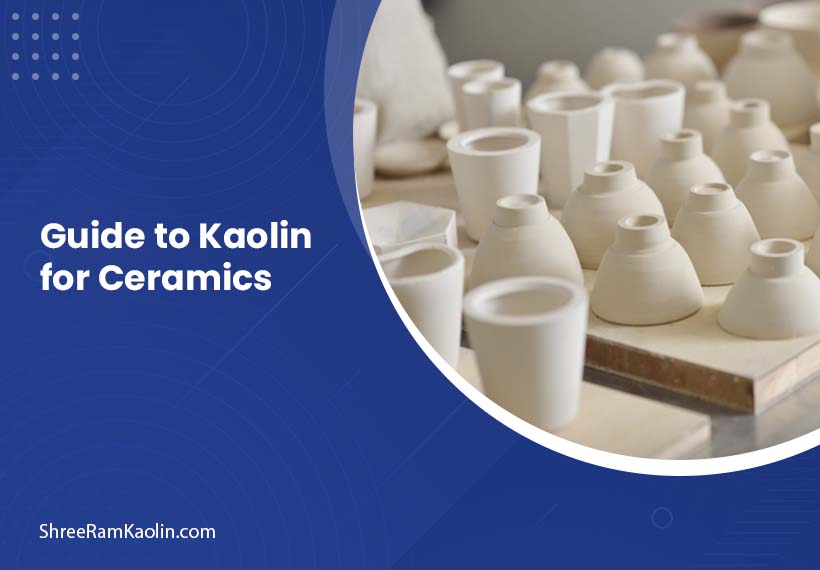The Essential Guide to Kaolin for Ceramics

Kaolin, one of the world’s most commonly used raw materials, plays an instrumental role in shaping ceramic products of all varieties and characteristics. We present here an informative and exhaustive guide, we’ll delve into the essential aspects of kaolin for ceramics, exploring its properties, applications, and the impact it has on the artistic and functional aspects of ceramic creations.
What is Kaolin?
Definition and Origin
Kaolin (or china clay), is a naturally occurring soft clay mineral that derives its name from where it first surfaced centuries ago in China. Kaolin forms through the weathering of feldspar minerals containing aluminum silicate.
Composition and Color Variations
Kaolin is composed primarily of kaolinite, an ore of the kaolinite-serpentine group of minerals. It can range in color from white to various hues of yellow, red or even pink depending on the impurities present within its structure.
Kaolin Mining and Processing
Extraction Methods
Kaolin is typically mined through open-pit mining methods. The extraction process begins by clearing away overburden before excavating strata-rich with kaolin deposits for extraction. Once mined, raw kaolin goes through processing to eliminate impurities and improve quality.
Processing Techniques
Processing techniques such as washing, drying, and micronization are used to transform kaolin for use in ceramics. These steps play a pivotal role in optimizing its physical and chemical properties.
Properties of Kaolin in Ceramics
Plasticity and Workability
Kaolin is highly sought-after due to its plasticity, making it ideal for shaping and molding ceramic production. Additionally, its fine particle size contributes to creating smooth textures and workability in clay bodies.
Fired Color and Thermal Stability
Kaolin displays outstanding thermal stability when fired. There is minimal color change as a result, helping ensure that finished ceramic products maintain their aesthetic qualities.
Applications of Kaolin in Ceramics

Glaze Formulation
Kaolin is an essential element in glaze formulation. It adds desirable properties such as opacity, glossiness, and suspension to glazes enhancing their visual appearance and increasing the visual appeal of ceramic surfaces.
Body Formulation
Kaolin acts as a binding agent in ceramic body formulations, contributing to the overall strength and structure of the clay while its presence impacts the firing temperature as well as the texture of the final ceramic product.
Innovations and Trends
Nano-Kaolin in Modern Ceramics
Recent breakthroughs have shown the use of nanosized kaolin particles in ceramics to further boost strength, producing ceramics with unique properties and creating ceramic products with custom applications.
Environmental Impact and Sustainability
Sustainable Mining Practices
As the ceramic industry places more of an emphasis on sustainable practices, efforts are underway to implement eco-friendly mining procedures for kaolin. This involves reclamation of mined areas while simultaneously limiting environmental damage.
The Role of Kaolin in Ceramic Masterpieces
Kaolin stands as an unsung hero in ceramics, lending artists and sculptors the tools to craft timeless masterpieces with ease. This section explores all the ways kaolin contributes to both artistry and functionality in ceramics.
Kaolin’s Influence on Ceramic Aesthetics
Texture and Surface Finish
Kaolin’s fine particle size adds velvety textures to ceramic surfaces, offering tactile experiences for artists and admirers. Kaolin also contributes towards smooth surface finishes which increases the visual appeal of ceramic artworks.
Color Palette Expansion
Kaolin provides ceramicists with an endless range of color variations. Ranging from classic white hues to warmer earth tones, artists have the freedom to experiment with various hues that will add depth and character to their creations.
Pushing Boundaries: Kaolin in Contemporary Ceramics
Kaolin-Infused Sculptures
Contemporary ceramic artists continue to push the limits by exploring creative uses for kaolin in sculptures and installations, showing its adaptability and versatility. Kaolin-infused sculptures display this beautifully.
Kaolin as a Canvas
Some artists employ kaolin itself as their canvas; its natural hue variations become integral components of artistic expression, forging a harmonious partnership between this raw material and an artist’s vision.
Beyond Tradition: Kaolin in Functional Ceramics
Kaolin in Tableware
Kaolin plays an integral part in functional ceramics as well, from tableware durability enhancements to helping everyday items maintain their aesthetic value over time.
Kaolin in Industrial Ceramics
Kaolin is widely used in industrial ceramics to strengthen the structural integrity of products such as tiles and sanitaryware, due to its ability to withstand high temperatures while maintaining color stability – an attractive feature in these applications.
FAQs About Kaolin in Ceramics
Is kaolin suitable for all types of ceramics?
Kaolin is versatile and can be used in various types of ceramics, from sculptural artworks to functional tableware.
How does kaolin contribute to glaze formulation?
Kaolin imparts opacity, gloss, and suspension to glazes, enhancing the visual appeal of ceramic surfaces.
Can kaolin be used in combination with other clays?
Yes, kaolin is often blended with other clays to achieve specific characteristics in the clay body.
Are there any environmental concerns associated with kaolin mining?
Efforts are being made to implement sustainable mining practices for kaolin, minimizing environmental impact and promoting reclamation.
What are the emerging trends in utilizing kaolin in modern ceramics?
Nanotechnology is exploring the use of nano-sized kaolin particles, introducing new possibilities and properties in ceramic production.
Conclusion
Kaolin’s use in ceramics has long been an established practice that continues to progress alongside advances in technology and sustainable practices. From shaping clay bodies to improving glazes, this versatile substance remains indispensable within ceramic production.
Looking for reliable kaolin for your ceramic industry? Shree Ram Kaolin, The Most Trusted Kaolin Manufacturer since 1977, offers unparalleled quality and expertise. Count on them for top-notch products, ensuring your ceramic needs are met with reliability and experience.

